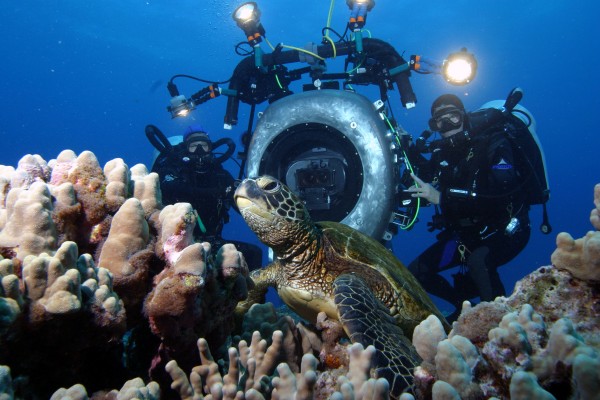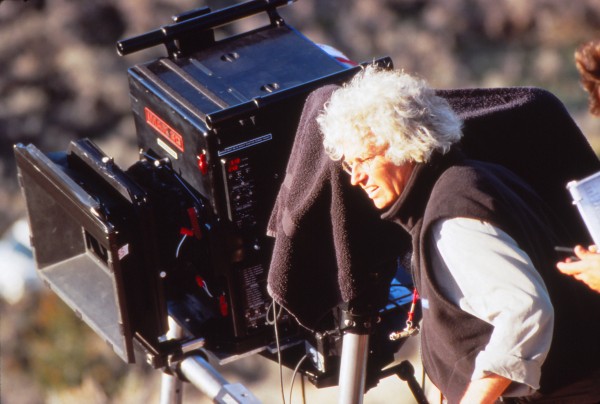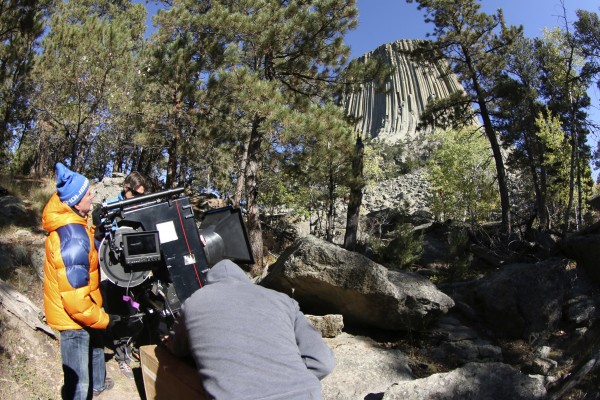A stereoscopic film format using IMAX 15/70 film, and projected on giant screens. Requires specialized camera and projection equipment, including 3D glasses.
Film Explorer

A left and right stereopair from Transitions (Colin Low & Tony Ianzelo, 1986). These are the 65mm interpositives – printing elements made as back-ups in case the original negative becomes damaged. Original IMAX 3D prints would have been made on 70mm film.
National Film Board of Canada, Montreal, Quebec, Canada.
Identification
69.596mm x 48.514mm (2.74 in x 1.91 in).
Eastman EXR 2386, Kodak Vision 2383 [non-exhaustive list].
Standard Eastman Kodak edge markings, prints are labeled as “left-eye” or “right-eye”.
2
Films were projected with full spectrum Xenon daylight Illumination at ~6000 Kelvin color temperature.
IMAX 3D
Dual system, no audio on prints. Six channels of uncompressed digital audio from proprietary playback unit using three compact discs. Some 3-D films incorporated the IMAX Personal Sound Environment (IMAX PSE), a headset with 3-D Electronic Liquid Crystal Shutter Glasses (E3D) and headphones that would deliver an additional two channels of binaural sound to each viewer.
Additional two channels for IMAX PSE system, from speakers in the headset.
70.41mm x 52.63mm (2.772 in x 2.032 in).
15-perforation, horizontal (twin strip); 30-perforation, horizontal (space camera).
Eastman Color II 100T 5247, Eastman EXR 500T 5298, Kodak Vision 500T 5279, Fuji 65, Fuji 250, Fuji 500 [non-exhaustive list].
Standard Eastman Kodak or Fuji edge markings.
History
While the first IMAX 3D film was released 15 years after IMAX’s 1970 debut, the format’s possibilities as a 3-D medium were immediately apparent, particularly among filmmakers affiliated with the National Film Board of Canada (NFB). In their first decade, the IMAX Corporation’s priorities were to establish production systems and theatre networks, while continuing to pursue innovation, in large part through World’s Fair experiments including NFB collaborations that would lay the groundwork for IMAX 3D. NFB Commissioner Sydney Newman, inspired by his encounter with Stereo 70 (a 3-D system at EXPO 70’s Russian pavilion), and the NFB’s history of 3-D animation (particularly Norman McLaren), proposed a 3-D film as Canada’s contribution to the American Bicentennial in 1976. (Low 1983, 42) While the Bicentennial project was never realized, it spurred 3-D research at the NFB, including a 1973 trip to NIKFI (Scientific Research Film and Photo Institute), Moscow, by Colin Low, John Spotton and Ernest McNabb to learn about their stereoscopic film practices. While Cold War contingencies stymied aspirations for Canada–USSR collaborative filmmaking, these exchanges were invaluable in cultivating technical expertise and artistic creativity in 3-D production.
The first stereoscopic IMAX film was We Are Born of Stars, Roman Kroitor’s animated film projected in single-strip anaglyph in an OMNIMAX theater at the 1985 Tsukuba World’s Fair in Japan. While dome-based stereoscopy was, by its nature, a very limited format, We Are Born of Stars would prove an important milestone in computer animation. The following year, the first flat-screen IMAX 3D theater was built in the CN Pavilion (Canadian National Railway) at Expo 86 in Vancouver, British Columbia, featuring the first live-action IMAX 3D film, Transitions, produced by the NFB. The 3-D camera rig for this production involved a crane supporting two full-size IMAX cameras positioned at 90 degrees to each other, with a half-silvered mirror between them. In this configuration, the left-eye camera lens axis pointed downward, while the right-eye lens axis pointed ahead. While the resulting film produced good results, and a refined version of this rig would be used for Echoes of the Sun and The Last Buffalo (both 1990), IMAX also developed a single-camera system called Solido, that would be used on most IMAX 3D films. (Note that this term is related, but not identical to the Solido projection system, detailed in the IMAX Solido entry.)
The Solido IMAX 3D camera was designed with several goals in mind. First, a single camera integrating the left- and right-eye components would be easier to operate, with reduced size and weight that allowed for greater camera mobility. The camera incorporated two 15/65 movements into one camera body, and refined the advancement mechanism: making it smaller, more easily synchronized, and with an adjustable frame rate. It also included microprocessor-controlled shutters and lenses, further ensuring perfect alignment of the left- and right-eye apparatus, while reducing the number of moving parts required to operate the camera. This camera had two lenses in a fixed position 2.85 in. (72.4mm) apart, a distance approaching the average 64mm interocular distance (measured between the pupil of each eye) of an adult (Imax Corporation, 1997). As many of the existing IMAX lenses, particularly the fish-eye lens, were too large for this camera, Hughes Leitz of Canada Ltd. created a 30mm fish-eye lens pair, scaled for the camera. IMAX also created matched 40mm, 60mm and 80mm 3-D lenses.
Another significant development were variants of the IMAX 3D camera designed for use on the Space Shuttle in orbit, including a Cabin Camera for interior shots, and a Cargo Bay Camera installed in position to photograph exterior shots. These were used to shoot Space Station 3D (2002) and Hubble 3D (2010) through IMAX’s collaboration with NASA, the National Air and Space Museum and Lockheed Martin Corporation. The space cameras advanced two frames at a time (30-perf, pull-across), recording the left- and right-eye images simultaneously on adjacent frames of a single strip of film (later separated with an optical printer) – improving camera size, usability and efficient use of film stock. The interocular distance for the Cabin Camera was 5mm shorter than standard, in order to mitigate the miniaturizing effect as a result of subjects being relatively close to the camera, given the confined geometry of the spacecraft (Duncan, 2006: p. 101).
Since We Are Born of Stars, animation has been a significant innovative force in IMAX 3D filmmaking, notably the SANDDE system (a portmanteau of the Japanese words for “three” and “D”; also, an acronym of Stereoscopic Animation Drawing Device), patented by Roman Kroitor and used extensively by NFB filmmakers. While SANDDE can be used for films of any format, the compositional versatility afforded by IMAX’s scale was important to its conceptualization. SANDDE allowed the animator to create images by moving 3-D models through virtual 3-D space, rather than modeling 3-D forms and projecting them onto a 2-D plane. The first film made with the format was Paint Misbehavin’ in 1997.
While fully digital 3-D processes are now ubiquitous, 15/70 IMAX 3D has been used in film production as recently as 2017’s Dream Big: Engineering Our World (MacGillivray Freeman Films). The format has allowed for decades of sustained technical and creative innovation in stereoscopic filmmaking, and has impacted the development of subsequent 3-D production in all formats. As of 2025, the cinema at the Gujarat Science City in Ahmedabad, India, is still projecting IMAX 3D in dual-strip 70mm.

Director Howard Hall (right) filming Deep Sea 3D (2006) with the IMAX Solido 3-D camera in its underwater housing.
IMAX Corporation.

Director Jean-Jacques Annaud filming with the IMAX Solido 3-D camera, Wings of Courage (1995).
Sony Pictures Classics, Large Format.

Director Greg MacGillivray (left) filming with the IMAX Solido 3-D camera at Devil's Tower, Wyoming, National Parks Adventure (2016).
MacGillivray Freeman Films.
Selected Filmography
Notable for production design for the PSE (Personal Sound Environment) headset.
Notable for production design for the PSE (Personal Sound Environment) headset.
Notable for use of underwater camera housing for the IMAX Solido 3-D camera.
Notable for use of underwater camera housing for the IMAX Solido 3-D camera.
First use of SANDDE animation system.
First use of SANDDE animation system.
The first Hollywood feature film to undergo DMR remastering for IMAX 3D release (IMAX was not used for image capture).
The first Hollywood feature film to undergo DMR remastering for IMAX 3D release (IMAX was not used for image capture).
Merging of animation and live action, and an example of a film made with both IMAX and other companies’ technologies, in this case the HinesLab Iwerks 3-D Camera beam-splitter camera rig, which could use both 8/70 and 15/70 film.
Merging of animation and live action, and an example of a film made with both IMAX and other companies’ technologies, in this case the HinesLab Iwerks 3-D Camera beam-splitter camera rig, which could use both 8/70 and 15/70 film.
First use of IMAX 3D cameras designed for use in space.
First use of IMAX 3D cameras designed for use in space.
First live-action IMAX 3D film. Produced for the Canada Pavilion at Expo 86 in Vancouver, Canada.
First live-action IMAX 3D film. Produced for the Canada Pavilion at Expo 86 in Vancouver, Canada.
Short animated film produced for the Fujitsu Pavilion at Expo 85 in Tsukuba, Japan. This was a precursor to IMAX 3D, using anaglyph, rather than two-strip polarization.
Short animated film produced for the Fujitsu Pavilion at Expo 85 in Tsukuba, Japan. This was a precursor to IMAX 3D, using anaglyph, rather than two-strip polarization.
First IMAX 3D dramatic narrative film.
First IMAX 3D dramatic narrative film.
Technology
IMAX 3D film projection requires two 15/70 IMAX prints (left- and right-eye records) projected in synchronization at 24fps through perpendicular, linear polarized filters (i.e. oriented at 90 degrees to each other), while viewers wore polarized glasses to recreate image separation for the stereoscopic effect. The first IMAX 3D rig incorporated two IMAX cameras (one for each eye), while later-generation cameras ran two strips of 15/65 film in one housing. In the IMAX 3D cameras designed for use in space, the left- and right-eye images were recorded on a single strip of film, and subsequently separated in post-production.
IMAX’s projection system reduced or eliminated many of the contingencies that had impeded sustained innovations in stereoscopic cinema. First, viewer discomfort was mitigated by the stability of the projection, thanks to the horizontal film movement and a system that placed each frame in direct contact with the field lens during projection, creating an extremely stable image. Second, the rolling loop minimized print damage, reducing the need for time-consuming print modifications to maintain uniformity of the left- and right-eye prints. Third, the image size and wider field of view allowed for more complex compositions in 3-D space, accommodating greater creativity than earlier 3-D systems (Low, 1983 & 1998; Douglas, 1994). Finally, the intricacy and spatial resolution of the IMAX sound system worked in concert with the complex 3-D visual compositions to create a much-enhanced viewer experience. Indeed, it is common practice for sound editors to wear 3-D glasses during the editing process, so they can ensure that the sound design corresponds with the spatial properties of the image.
The production of Transitions, and its exhibition at Expo 86, provided valuable opportunities to explore 3-D technology and associated aesthetics, and to refine both the camera rig and the prototype two-strip 3-D projector, leading to both systems becoming more practical and reliable. On the exhibition side, the first generation of 3-D projectors would be equipped with a coupling system to ensure synchronization of the two prints, while the subsequent dual-rotor GT3D projector, featuring twin rotors, lamphouses and platters integrated in one system, would debut at Expo 90. Other improvements included refined polarization to ameliorate ghosting (where image separation is compromised), advances in 3-D glasses, and construction, materials, and transportation solutions for 3-D screens. They developed a reflective aluminum-based paint surface for 3-D screens, both to maintain suitable light levels and to preserve the polarization necessary for the 3-D effect. The spray-painting rig (to apply the paint in-situ, avoiding cracking and damage in transport) was tested before Expo 90 (Douglas 1994 “3D Projection Systems”).
Most IMAX 3D projection uses polarizing filters set at 90 degrees to one another, with corresponding filters on the glasses, ensuring that the right and left eye images remain separate. A common issue in 3-D projection is light loss from the multiple filters, so designers had to find a balance between light intensity, resulting heat levels from the projector, and image quality. (Douglas 1994, “Large Screen Technical Development”) Some IMAX 3D cinemas have used liquid-crystal shutter glasses, introduced at Expo ’90, where the lenses and projector are synchronized so that, for example, the left-eye image is projected just as the right lens of the glasses become opaque, alternating in time with the frame rate. In some cases these glasses would incorporate the PSE system, adding two extra sound channels directly into the viewers’ ears to enhance the 3-D effect. However, simple polarization is most common due to the expense of LCD maintenance (Douglas, 1987–94).
On the production side, while streamlined versions of two-camera beam-splitter rigs would remain in occasional use (particularly for shooting especially large and small subjects that benefit from an adjustable interocular distance), the single-housing Solido IMAX 3D camera, introduced in 1993, would allow for greater versatility in filmmaking. Not only was the camera more portable and user-friendly, but its size and higher degree of automation made it more practical for vehicle and aircraft mounts, and for use in underwater cinematography. While challenges remained, such as camera reloading taking approximately twice as long as for 2D, and the need for strategic set and costume considerations to prevent ghosting effects, the equipment was quite versatile and allowed for significant creative advances in 3-D filmmaking (Zone, 2012: p. 187; Imax Corporation, 1999: p. 14).
References
Duncan, Lauren K. (2006). “3-D and the Era of Immersion (1985-2005): The Historic Implications of Modern Stereo Film Technology on Content and Presentation”. PhD dissertation, Regent University, Virginia Beach, VA.
Imax Corporation (1997). IMAX 3D Camera Revised (May 12). Toronto: Imax Corporation Communications Department. VHS Tape.
Imax Corporation (1999). IMAX: The 15/70 Filmmaker’s Manual. Toronto: Imax Corporation. www.imax.com.
Low, Colin (1983). “Large Screen 3-D – Aesthetic and technical considerations”. Perforations, (July): pp. 42–4. Published by Technical and Production Services, National Film Board of Canada.
Low, Colin (1998). Personal Interview, Montreal, Canada (April 7).
Douglas, Creighton (1994a). “3D Projection Systems”. Creighton Douglas Fonds, Series: IMAX Systems Corporation. Research and Development Projects. R12389-183-0-E, Vol. 9, File 15. Library and Archives Canada, Ottawa, ON.
Douglas, Creighton (1994b). “Large Screen Technical Development”. Creighton Douglas Fonds, Series: IMAX Systems Corporation, Large Screen Technical Development, 1 of 2, 1994. R12389-183-0-E, Vol. 9, File 3. Library and Archives Canada, Ottawa, ON.
Zone, Ray (2012). 3D Revolution: The History of Modern Stereoscopic Cinema. Lexington, KY: University Press of Kentucky.
Patents
Shaw, William C. and Marian Toporkiewicz. 3-D motion picture projection apparatus. US parent US4971435A, filed September 8, 1989, issued November 20, 1990. https://patents.google.com/patent/US4971435A
Shaw, William C. and Gordon W. Harris. Camera and method of producing and displaying a 3-D motion picture. US patent US4993828A, filed May 11, 1989, issued February 19, 1991. https://patents.google.com/patent/US4993828A
Baljet, Anton L., Gerard C. Carter, and Gordon W. Harris. Projection synchronization system. US patent US5002387, filed March 23, 1990, issued March 26, 1991. https://patents.google.com/patent/US5002387A/en?oq=US5002387
Kroitor, Roman B. Method and apparatus for creating three dimensional drawings. US patent US5847710A, filed November 24, 1995, issued December 8, 1998. https://patents.google.com/patent/US5847710A
Edwards, William Thomas. 3-D glasses with variable duty cycle shutter lenses. US patent US577412A, filed January 3, 1996, issued February 10, 1998. https://patents.google.com/patent/US5717412A
Toporkiewicz, Marian and Michael A. Gibbon. Convertible 2-D/3-D Projector. US patent US6084654A, filed June 30, 1998, issued July 4, 2000. https://patents.google.com/patent/US6084654A
Preceded by
Followed by
Compare
Related entries
Author
Allison Whitney is an Associate Professor of Film and Media Studies in the Department of English at Texas Tech University, Lubbock, TX, United States. Her expertise is in film technology and she is a member of the research team “Locating Transnational Collaborations in the Early History of Imax Films and Architectures (1970–1990)” http://imax-history.ca
Whitney, Allison (2025). “IMAX 3D”. In James Layton (ed.), Film Atlas. www.filmatlas.com. Brussels: International Federation of Film Archives / Rochester, NY: George Eastman Museum.


